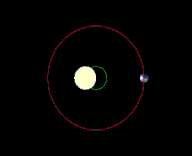
Back أدنى كتلة Arabic Massa mínima Catalan Minimuma maso Esperanto Masa mínima Spanish Masse minimale French Massa minima Italian 下限質量 Japanese Минимална маса Macedonian Jisim minimum Malay Masa minimalna Polish
Right: In this case none of the star's movement is along the viewer's line-of-sight and the Doppler spectroscopy method will not detect the planet at all.
In astronomy, minimum mass is the lower-bound calculated mass of observed objects such as planets, stars and binary systems,[1] nebulae,[2] and black holes.
Minimum mass is a widely cited statistic for extrasolar planets detected by the radial velocity method or Doppler spectroscopy, and is determined using the binary mass function. This method reveals planets by measuring changes in the movement of stars in the line-of-sight, so the real orbital inclinations and true masses of the planets are generally unknown.[3] This is a result of sin i degeneracy.
If inclination i can be determined, the true mass can be obtained from the calculated minimum mass using the following relationship:
© MMXXIII Rich X Search. We shall prevail. All rights reserved. Rich X Search


